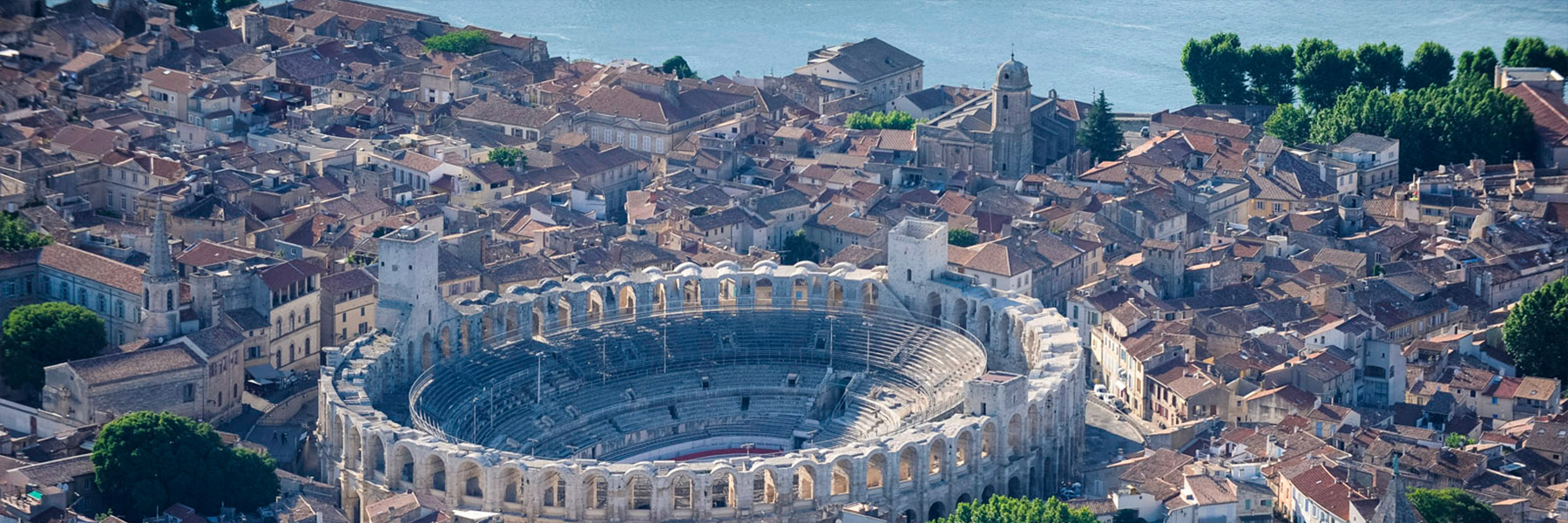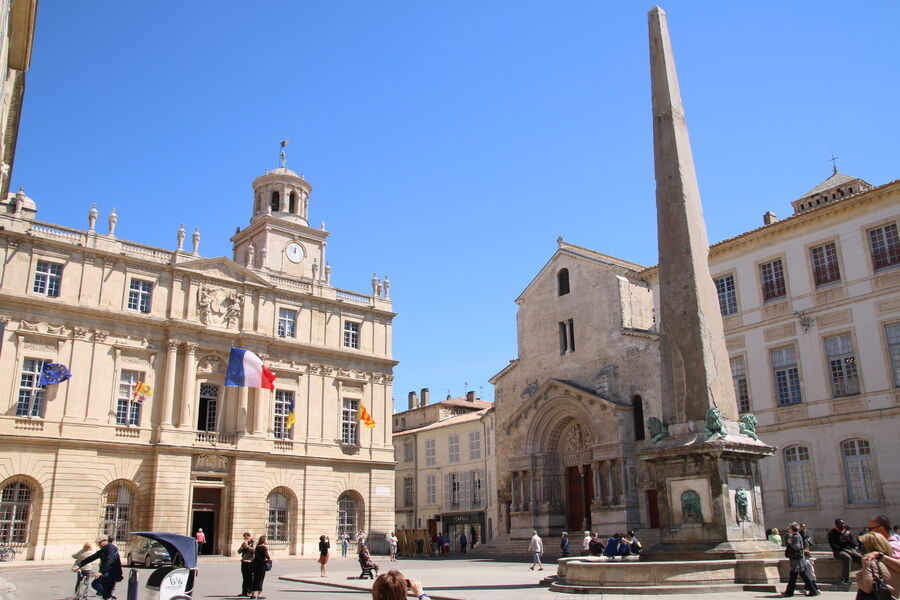L'obélisque romain
Date: 4th century
Period: Antiquity
Type: Public votive architecture
Status: Public domain Listed as a Historic Monument (1840), Unesco World Heritage (1981)
Date: 4th century
Era: Antiquity
Type: Votive public architecture
Status: Public estate listed as a national Historic Monument in 1840 and a UNESCO Heritage Site in 1981
The obelisk seen from the town hall roof
The large stone needle, a kind of pivot on the Place de la République, actually comes from the Roman circus and dates from late Antiquity.
The obelisk was discovered in the 14th century, but it was not until the 17th century that it became a symbol of the sun once again.
It was transported and installed, with great difficulty, in front of the newly built hôtel de ville.
It is adorned with a fountain and a basin and it sets the standard for the harmony of the different styles of façades around the square.
It is also the best viewpoint for taking in vast panorama of the Place de la République.
A symbol of the sun and the Empire in Antiquity and a decorative feature, the obelisk also served as a landmark for charioteers in the heart of the Roman circus.
We now know that the structure was created from granite taken from a Roman quarry in Asia Minor.
It is monolithic in design (it was split in two at the end of Antiquity) and, together with the pedestal designed by the Arles architect Jacques Peytret, it measures around 20 metres.
Fassin and Lieutaud (1909) provided the following information: 15.26 m high, 1.7 wide at the base; the pedestal is 4.55 m high.
The point was surmounted by a bronze globe scattered with fleur de lys, which was topped with a golden sun.
The obelisk comes from the spina (central wall around which the track ran) of the Roman circus.
It was erected there during major work carried out on the building in the 4th century.
After the building was abandoned in the 6th century, the obelisk collapsed and broke in two.
It was rediscovered in 1389 and regularly shown to important visitors, such as Henri IV, who wanted it to be placed in the centre of the amphitheatre.
However, the consuls decided to erect it on the Place Royale, in front of the new hôtel de ville, 'for the greater glory of King Louis XIV'.
It took 40 days to transport and required colossal manpower to move it a distance of a few hundred metres.
The majority of the shaft was close to the original site and the four-metre long point was on Place Antonelle, in the La Roquette district... where it was being used as a bench.
But it was even more difficult to raise it on its pedestal (its foundations revealed the existence of Roman thermal baths on this site).
Mariners specialised in handling boat masts were called in. On 26 March 1676, the operation ended with the installation of the point.
It was then possible to install the Royal symbol, a bronze globe topped with a sun. This globe was later replaced by other symbols, including a Phrygian cap, a Napoleonic eagle and the cockerel of the July Monarchy, before the Royal sun was put back (removed permanently in 1866).
The stone lions, originally placed there in the 17th century, were replaced in 1829 by bronze lions sculpted by Dantan.
Henri Révoil restored the building in 1866-1867 and added fountains and a basin, decorated with masks of Hercules.
Period: Antiquity
Type: Public votive architecture
Status: Public domain Listed as a Historic Monument (1840), Unesco World Heritage (1981)
Date: 4th century
Era: Antiquity
Type: Votive public architecture
Status: Public estate listed as a national Historic Monument in 1840 and a UNESCO Heritage Site in 1981
The obelisk seen from the town hall roof
The large stone needle, a kind of pivot on the Place de la République, actually comes from the Roman circus and dates from late Antiquity.
The obelisk was discovered in the 14th century, but it was not until the 17th century that it became a symbol of the sun once again.
It was transported and installed, with great difficulty, in front of the newly built hôtel de ville.
It is adorned with a fountain and a basin and it sets the standard for the harmony of the different styles of façades around the square.
It is also the best viewpoint for taking in vast panorama of the Place de la République.
A symbol of the sun and the Empire in Antiquity and a decorative feature, the obelisk also served as a landmark for charioteers in the heart of the Roman circus.
We now know that the structure was created from granite taken from a Roman quarry in Asia Minor.
It is monolithic in design (it was split in two at the end of Antiquity) and, together with the pedestal designed by the Arles architect Jacques Peytret, it measures around 20 metres.
Fassin and Lieutaud (1909) provided the following information: 15.26 m high, 1.7 wide at the base; the pedestal is 4.55 m high.
The point was surmounted by a bronze globe scattered with fleur de lys, which was topped with a golden sun.
The obelisk comes from the spina (central wall around which the track ran) of the Roman circus.
It was erected there during major work carried out on the building in the 4th century.
After the building was abandoned in the 6th century, the obelisk collapsed and broke in two.
It was rediscovered in 1389 and regularly shown to important visitors, such as Henri IV, who wanted it to be placed in the centre of the amphitheatre.
However, the consuls decided to erect it on the Place Royale, in front of the new hôtel de ville, 'for the greater glory of King Louis XIV'.
It took 40 days to transport and required colossal manpower to move it a distance of a few hundred metres.
The majority of the shaft was close to the original site and the four-metre long point was on Place Antonelle, in the La Roquette district... where it was being used as a bench.
But it was even more difficult to raise it on its pedestal (its foundations revealed the existence of Roman thermal baths on this site).
Mariners specialised in handling boat masts were called in. On 26 March 1676, the operation ended with the installation of the point.
It was then possible to install the Royal symbol, a bronze globe topped with a sun. This globe was later replaced by other symbols, including a Phrygian cap, a Napoleonic eagle and the cockerel of the July Monarchy, before the Royal sun was put back (removed permanently in 1866).
The stone lions, originally placed there in the 17th century, were replaced in 1829 by bronze lions sculpted by Dantan.
Henri Révoil restored the building in 1866-1867 and added fountains and a basin, decorated with masks of Hercules.

